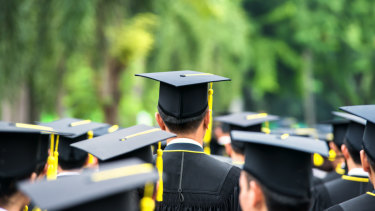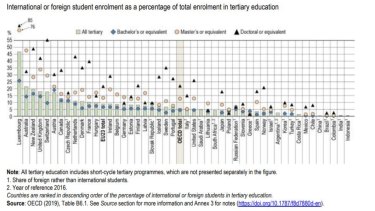International students at Australian universities make up nearly half of all master's enrolments and one-third of doctoral candidates, making the country's higher-degree programs disproportionately dependent on the foreign market.
International students make up 21 per cent of all tertiary enrolments in Australia, compared to an average of 6 per cent in other countries, according to the OECD's latest annual report comparing educational outcomes around the world.

Foreign students make up 14 per cent of all enrolments in bachelor's degrees at Australian universities but represent 48 per cent of all master's students and 32 per cent of doctoral candidates, which experts say will lead to a brain drain when these students return to their home countries.
"Currently, Australian universities depend on international students for their survival of higher-degree programs," said Jihyun Lee, an associate professor at UNSW.
"While the Australian government provides up to four years of post-degree stay for international students, it is inevitable that Australia faces a drain of highly educated specialists."
The chief executive of peak body Universities Australia, Catriona Jackson, said the proportion of international students enrolled in Australian "higher-degree programs is comparable to other popular study destinations, like the United Kingdom".
“International higher-degree students are a fundamental part of our growing international research collaborations with benefits for the nation and for our economy. And once they graduate, they form a global knowledge network who are very important for Australia’s connections worldwide," Ms Jackson said.

Overall, Australia "takes in 10 per cent of all the international or foreign tertiary students in OECD member countries, one of the largest shares across OECD countries", says the OECD report.
The report also shows that domestic students in Australia are less likely to hold a master's or doctoral degree than those in other countries.
About 51 per cent of Australians aged between 25 and 34 hold a tertiary degree, compared to the OECD average of 44 per cent, but only 10 per cent have studied beyond a bachelor's degree, compared to an OECD average of 15 per cent.
There is also a widening gender gap in the attainment of university degrees, with 59 per cent of women in Australia holding a degree in 2018 compared to 44 per cent of men.
This gap increased by 9 percentage points between 2008 and 2018, the report says.
Meanwhile, Australia's public expenditure on school education has fallen from 10.4 per cent of total government expenditure in 2010 to 8.9 per cent in 2016.
However, spending on non-tertiary education as a percentage of total government expenditure and in dollar terms per student remains above the OECD average.
In 2016, Australia spent $10,013 in US dollars on primary education per full-time equivalent student and $11,651 on secondary education, compared to an OECD average of $8470 and $9968 respectively.
Federal Education Minister Dan Tehan said: "When compared to other OECD countries, Australia’s education system is well funded, has high levels of access, participation and attainment, and delivers good labour market outcomes.”
Australian teachers also earn some of the highest average salaries in the OECD at $56,196 in US dollars for high school teachers and $55,312 for primary school teachers, compared to OECD averages of $42,553 and $40,580 respectively.
However, teaching hours per year are also far higher in Australia than in most other countries, at 870 hours for primary school teachers in 2018 and 811 hours for high school teachers.
The OECD average is 776 hours for primary school teachers and 668 hours for high school teachers.
Teachers' average salaries at all levels of education across the OECD are between 78 per cent and 93 per cent of the earnings of other tertiary-education workers, the report finds.
The Grattan Institute's school education expert, Peter Goss, said salaries were relatively high across all professions in Australia in real dollar terms compared to other countries, but Australian teachers' salaries were flatter than those of other professions.
"Early on, teachers' salaries are very competitive with salaries for other graduates but as teachers move into their 30s, 40s and 50s, the top end of those salaries falls way behind other full-time workers with a bachelor's degree, even if you're a high achiever," Dr Goss said.
NSW Teachers' Federation president Maurie Mulheron said Australian teachers were required to do a lot more than those in other countries.
"Australia is one of the most challenging systems in terms of geography and rural and remote schools, which most other countries don't have to the same extent," Mr Mulheron said.
"We also have one of the highest concentrations of disadvantaged students in disadvantaged schools, we ask a lot more of our teachers."
The OECD report also finds that only 67 per cent of Australian three-year-olds were enrolled in early childhood education in 2017, compared to an OECD average of 79 per cent.
However, Australia's rate of enrolment for four and five-year-olds has increased over the past seven years to 86 per cent and 99 per cent.
Blog was amazing and worth a while.Vietnam Tour Package
ReplyDelete